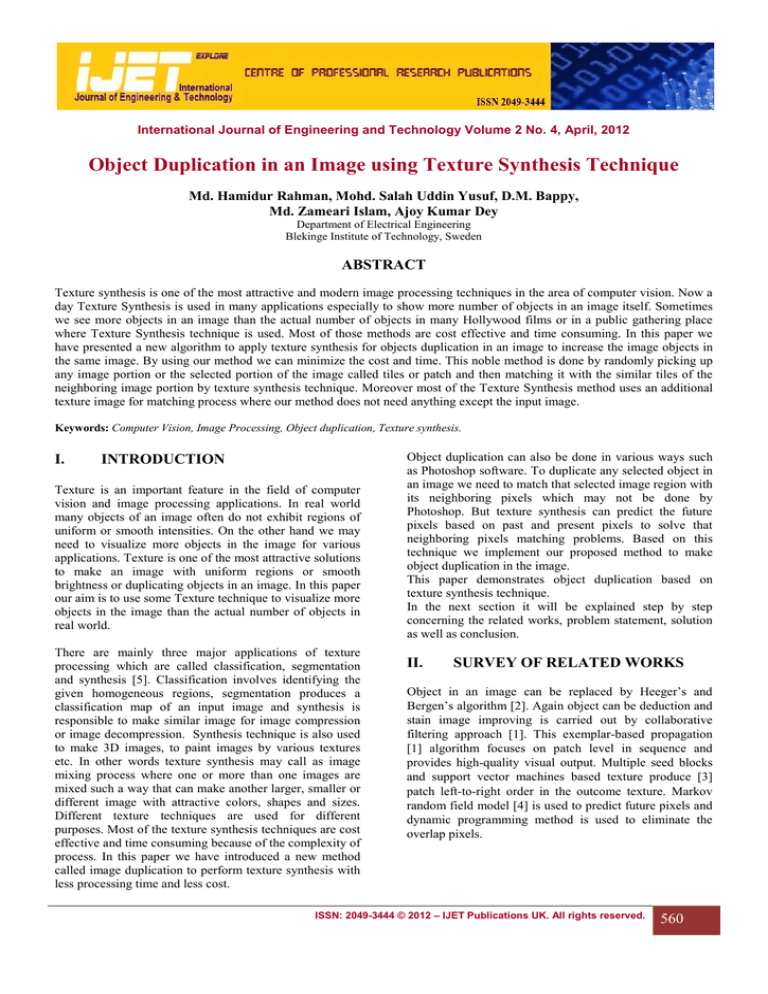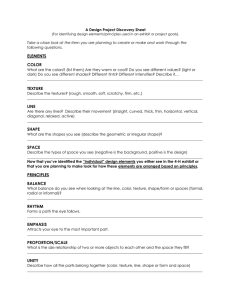
International Journal of Engineering and Technology Volume 2 No. 4, April, 2012
Object Duplication in an Image using Texture Synthesis Technique
Md. Hamidur Rahman, Mohd. Salah Uddin Yusuf, D.M. Bappy,
Md. Zameari Islam, Ajoy Kumar Dey
Department of Electrical Engineering
Blekinge Institute of Technology, Sweden
ABSTRACT
Texture synthesis is one of the most attractive and modern image processing techniques in the area of computer vision. Now a
day Texture Synthesis is used in many applications especially to show more number of objects in an image itself. Sometimes
we see more objects in an image than the actual number of objects in many Hollywood films or in a public gathering place
where Texture Synthesis technique is used. Most of those methods are cost effective and time consuming. In this paper we
have presented a new algorithm to apply texture synthesis for objects duplication in an image to increase the image objects in
the same image. By using our method we can minimize the cost and time. This noble method is done by randomly picking up
any image portion or the selected portion of the image called tiles or patch and then matching it with the similar tiles of the
neighboring image portion by texture synthesis technique. Moreover most of the Texture Synthesis method uses an additional
texture image for matching process where our method does not need anything except the input image.
Keywords: Computer Vision, Image Processing, Object duplication, Texture synthesis.
I.
INTRODUCTION
Texture is an important feature in the field of computer
vision and image processing applications. In real world
many objects of an image often do not exhibit regions of
uniform or smooth intensities. On the other hand we may
need to visualize more objects in the image for various
applications. Texture is one of the most attractive solutions
to make an image with uniform regions or smooth
brightness or duplicating objects in an image. In this paper
our aim is to use some Texture technique to visualize more
objects in the image than the actual number of objects in
real world.
There are mainly three major applications of texture
processing which are called classification, segmentation
and synthesis [5]. Classification involves identifying the
given homogeneous regions, segmentation produces a
classification map of an input image and synthesis is
responsible to make similar image for image compression
or image decompression. Synthesis technique is also used
to make 3D images, to paint images by various textures
etc. In other words texture synthesis may call as image
mixing process where one or more than one images are
mixed such a way that can make another larger, smaller or
different image with attractive colors, shapes and sizes.
Different texture techniques are used for different
purposes. Most of the texture synthesis techniques are cost
effective and time consuming because of the complexity of
process. In this paper we have introduced a new method
called image duplication to perform texture synthesis with
less processing time and less cost.
Object duplication can also be done in various ways such
as Photoshop software. To duplicate any selected object in
an image we need to match that selected image region with
its neighboring pixels which may not be done by
Photoshop. But texture synthesis can predict the future
pixels based on past and present pixels to solve that
neighboring pixels matching problems. Based on this
technique we implement our proposed method to make
object duplication in the image.
This paper demonstrates object duplication based on
texture synthesis technique.
In the next section it will be explained step by step
concerning the related works, problem statement, solution
as well as conclusion.
II.
SURVEY OF RELATED WORKS
Object in an image can be replaced by Heeger’s and
Bergen’s algorithm [2]. Again object can be deduction and
stain image improving is carried out by collaborative
filtering approach [1]. This exemplar-based propagation
[1] algorithm focuses on patch level in sequence and
provides high-quality visual output. Multiple seed blocks
and support vector machines based texture produce [3]
patch left-to-right order in the outcome texture. Markov
random field model [4] is used to predict future pixels and
dynamic programming method is used to eliminate the
overlap pixels.
ISSN: 2049-3444 © 2012 – IJET Publications UK. All rights reserved.
560
International Journal of Engineering and Technology (IJET) – Volume 2 No. 4, April, 2012
III.
PROBLEM STATEMENT AND
MAIN CONTRIBUTION
If we want to increase the number of objects in an image
the main problem is the uniform brightness and
smoothness of the regions. Image scaling technique can
make an image larger but it fails to increase the number of
objects. Photoshop or other tools are also used to duplicate
object but it cannot match neighboring pixels which make
the image ununiformed. Though texture can construct
larger digital image than an actual image, it is required to
find some technique to increase the number of objects in
the image and it can also make the image larger at the
same time.
Research question is how to apply texture synthesis
technique to increase the number of objects in an image
with uniform brightness and smoothness of all neighboring
pixels. The hypothesis is that at first we fix the output
image size and we divide that output image into a
summation of square regions with row and column. Then
we randomly take a small portion of the image called tiles
or patch from the input image and keep it into the output
image. Afterwards, we search a similar image tiles as the
neighboring image portion based on brightness matching
one after another by texture synthesis technique and put it
into output image. By using this brightness matching
and/or similar tiles searching and then attaching it in the
neighboring image portion can increase the number of
objects in an image.
The main contribution of this paper is to design an
algorithm and implementing the model using MATLAB
which is preceded by Markov random field model (MRF)
[4] and dynamic programming method.
IV.
Fig. 1 Block diagram of the model
B. Implementation
Let 𝐼 be the original image and its sample is taken as
𝐼𝑠𝑎𝑚𝑝𝑙𝑒 and 𝐼𝑠𝑎𝑚𝑝𝑙𝑒 ⊂ 𝐼𝑟𝑒𝑎𝑙 . 𝐼𝑟𝑒𝑎𝑙 is the image in the finite
texture. Let be pixel 𝑝 Є 𝐼. If the square image tile width is
ω then centre pixel ω(p) is 𝜔𝑝 ⊂ 𝐼 .
Let assume the space between two tiles is d(𝜔1 , 𝜔2 ) and all
pixels are known in the original image 𝐼 except pixel p.
Now we use the probability distribution P(𝑝|𝜔(𝑝)|) to
construct the approximation of the new matching tiles.
Using Markov Random Field (MRF) [4] it can be defined
pixel value set form the equation
Ω(𝑝) = �ώ ⊂ 𝐼𝑟𝑒𝑎𝑙 ∶ 𝑑�ώ, 𝜔(𝑝)� = 0�
(1)
Including all ω(p) in 𝐼𝑟𝑒𝑎𝑙
PROBLEM SOLUTION
A. Modeling
To model the proposed hypothesis a picture is taken as an
input image which is demonstrated in Fig 2. An object is
selected from the original image as a square window is
called patch or tile. This patch is used as a source of
probability to generate the future pixels. Here Markov
random field [4] is used to predict the future pixels. The
pixels are matched as the brightness value of its
neighborhood pixels. New tiles are made by MRF but need
to generate one after another. To generate patch from left
to right in the outcome texture multiple seed blocks and
support vector machines [3] are used. But in the outcome
texture some patches are overlapped. As a result pixels
brightness is changed in that area. To remove the
overlapping error in the boundary area dynamic random
method [4] is used.
Fig. 2 Original Image
Fig. 3 Patch or Tile
Fig .4. Matching the similar tiles as the neighboring image portion
one after another
ISSN: 2049-3444 © 2012 – IJET Publications UK. All rights reserved.
561
International Journal of Engineering and Technology (IJET) – Volume 2 No. 4, April, 2012
The overlap between the vertical and horizontal are found
as
1
𝜉
𝜉 ∗ = 𝑚𝑖𝑛𝜉 � ∑∀𝑟Є𝐼 𝛹𝑟 �
𝜉
(2)
𝜉
Dynamic programming method is used to cut the
horizontal & vertical overlaps error boundary. The
approach of minimal error boundary cut is shown in Fig.5.
Fig. 5 Dynamic programming method to cut the overlaps error
V.
CONCLUSION
This paper initiates texture synthesis technique to duplicate
object in an image as theoretical and experimental shadow.
Object duplication through texture synthesis offer a new
explanation to the object duplication problem for a certain
category of image.
This paper only espouses a simple model to duplicate the
object using texture. But this model does not work
properly for all tile size. If the tile size is decreased we
need more time and if the tile size is increased then the
neighboring pixel may not be uniformed. When minimal
error boundary cut some pixels are missed. As a result
object size and shape may change. So finding appropriate
size of the tiles may consider as future research.
REFERENCES
[1] X. Wu, W. Zeng, and Z. Li, “Exemplar-Based Image
Inpainting with Collaborative Filtering,” In Sixth
International Conference on Image and Graphics,
Hefei, Anhui, China, 2011, pp. 8 – 11, Aug, 2011.
[2] H. Igehy and L. Pereira, “Image Replacement through
Texture Synthesis,’’ Proceedings International
Conference On Image Processing, CA,USA , 1997,
pp. 186 - 189 vol.3, Oct 1997.
Fig. 6 Synthesized images
C. Validation
This model is implemented using MATLAB version
R2007a. Fig.2 illustrates the original image. Selecting the
ship as object Fig.3 from the original image and duplicate
it by using texture. Fig. 6 demonstrates the synthesized
image shows more objects.
In this simulation tile size is used as 200. Fig.4 shows the
similar tiles searching and attaching one after another in
the neighboring image portion. Here the overlap must be
less than the tile size.
[3] Dong, R. Wang, and X. Dong, “Texture Synthesis
Based on Multiple Seed-blocks and Support Vector
Machines’’ 3rd International Congress on Image and
Signal Processing (CISP-2010), Yantai , China, 2010,
pp. 2861 – 2864. Oct, 2010.
[4] A. A. Efros and T. K. Leung, “Texture Synthesis by
Non-parametric Sampling’’ IEEE International
Conference on Computer Vision, Corfu, Greece,
September 1999.
[5] G. Fan and X.G Gia, “Wavelet-based Texture analysis
and synthesis using Hidden Markov Model’’ IEEE
Transaction on Circuits and Systems-I: Fundamental
Theory
and
Applications,
vol.50,no.1,2003.
ISSN: 2049-3444 © 2012 – IJET Publications UK. All rights reserved.
562




